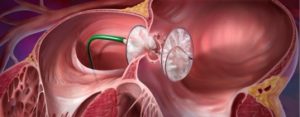Septal defects are small holes in the heart. They usually occur between the upper heart chambers – an atrial septal defect (ASD) or between the main pumping chambers of the heart – a ventricular septal defect (VSD).
ASDs and VSDs are congenital meaning that you are born with them but occasionally they are not detected until later in adult life. Small holes in the heart called patent foramen ovale (PFO) are very common and can be found in up to 1 in 4 people. PFOs are usually of no clinical importance.

How common is it?
ASDs and VSDs affect approximately 1 in 1000 adults. Small VSDs are more common in younger children and usually close by themselves before adulthood.
What symptoms might I get?
Often none but abnormal flows of blood within the heart can cause symptoms of breathless, tiredness and ankle swelling. Some patients can develop abnormalities of their heart rhythm.
What extra tests are required?
Most adults with a septal defect will require an assessment of whether the defect should be closed. This is usually with echocardiography but may also involve a cardiac MRI study or cardiac catheterisation study to measure the pressures in the heart chambers.
Will I need treatment?
Septal defects occasionally need closing to prevent heart failure. If the septal defect is large and / or is causing abnormal pressures within the heart then closure is recommended. This is usually performed using keyhole surgery from the top of the leg. A small device in implanted in the heart to seal the hole.
Is it hereditary?
Not usually.
Does this affect my life expectancy?
With appropriate medical care and treatment patients with a septal defect should have a normal life expectancy.
What happens next?
If you have been diagnosed with a septal defect then an appointment can be offered with a local cardiologist who can advise on further investigations and treatment.
Useful links
http://en.wikipedia.org/wiki/Atrial_septal_defect
http://en.wikipedia.org/wiki/Ventricular_septal_defect